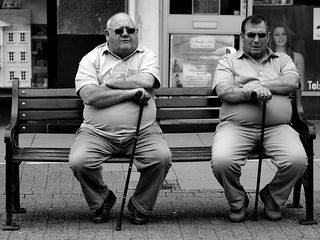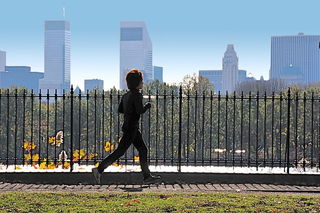Aging
Can You Move, Please?
How to get out of your own way and start moving toward a healthier life.
Posted May 19, 2019

Indulge me for a moment and imagine a pill. Imagine that it has very special properties: It costs nothing, reduces weight, lifts mood, and enhances sex drive. It has no adverse side effects—requires no prescription, pre-authorization, or referral. And you may take it anytime, anywhere, however you’d like—with food or without it. I’d take it. Wouldn’t you?
This magical pill? Movement.
A Vocabulary Lesson: Exercise vs. Movement
I prefer referring to exercise as movement because this seems like a much more palatable, less discouraging way of discussing it. The word exercise, at least for me, feels dirty and laborious, and it conjures images (and smells) of a stale, sweaty gym filled with people treadmill-ing furiously, perhaps on the verge of a very violent asthma attack.
As part of my ongoing training, I work alongside patients in various medical settings—primary care, sleep, and weight loss medicine clinics—to help them identify health goals and provide behavioral tools to achieve them. Many want to “exercise” but can’t. So the first tool I offer? A new word: movement. It feels lighter, more approachable, and less scary.
This seemingly small lexical tweak matters. As a gold standard psychological treatment for many conditions, such as depression, Cognitive Behavioral Therapy (CBT) assumes that thoughts influence emotions and behaviors. Learning to change how and what we think, in turn, can influence how we feel and what we do. Simply reframing exercise into movement can make the difference between walking or not.
Can you move, please?

To clarify: yes, I’ve policed your language and yes, I will now tell you to move but for good reason. Obesity rates have continued to rise in the United States, and adults over 60 appear at greatest risk. Among 65- to 74-year-old men, for example, obesity increased from 10.4 percent in 1960-1962 to 41.5 percent in 2007-2010. In women, the prevalence increased from 23.2 to 40.3 percent during the same period. For older adults especially, excess weight predicts disability related to cardiovascular and other chronic diseases, including type II diabetes, as well as increased functional limitation, reduced quality of life, depression, and all-cause mortality.
Adults over 60 also take the cake for sedentary behavior, spending nearly 80% of their waking time—8 to 12 hours—not moving. Many accept sedentary behavior as a risk factor for obesity itself and for other preventable diseases of the heart, bone, and brain: hypertension, arthritis, and even cognitive impairment.
How you move, of course, can take many forms but typically falls into four broad categories: (1) aerobics, (2) strength training, (3) balance, and (4) flexibility work. I recommend integrating components of each type into your repertoire, particularly if you have already started. But most importantly, if you haven’t, I invite you to consider starting with anything at all.
Types of movement
The many forms of movement can fit into more than one category. For example, many aerobic activities also build strength, but strength training can also improve balance.

Aerobic activity
Aerobic activity, sometimes called “cardio” or endurance training, refers to movement involving low- to high-intensity work that increases your heart rate and breathing. Examples of cardio include walking, jogging, dancing, sex, and house and yard work (all at once, if you like!). Its benefits seem unending, but some of the heavy-hitters include weight loss, increased endurance and strength, improved sleep, and reduced pain. Best yet, cardio stimulates a process called neurogenesis—the growth of new neurons—in the hippocampus, the brain’s primary memory center. Neurogenesis densifies the hippocampus, making the brain healthier and your memory, stronger.
But before tying your sneakers, please heed a few words of caution: stretch, take breaks, and build up to longer distance intervals. In the business, we call this pacing. It has a three-part formula: (1) time yourself across three movement trials and stop as soon as you start feeling pain; (2) average those times; (3) subtract 20%. Move for that amount of time initially, increasing your total time as tolerated, gradually.
Strength and resistance training

Resistance training targets muscle strength. During this type of workout, you move your limbs against resistance from weight (gym weights; your body’s own), gravity, and bands, or their combination. Like cardio, resistance training can improve strength and endurance, which play critical roles in everyday functioning. But it also does something that cardio doesn’t do as well: builds lean body mass. Lean body mass enhances your resting metabolic rate (RMR); how much energy (calories) you burn at rest while trying to maintain bodily functions such as respiration. RMR declines about 2 percent per decade after age 20, complicating weight loss and body composition with aging.
Fortunately, strength training can maintain as much lean body mass as possible, buoying RMR with aging. An added benefit? Lean body mass also helps to ward off insulin resistance and diabetes, keeping your brain and body healthy in the process.

Balance and flexibility activities
Finally, combined balance and flexibility work can help to prevent falls, stretch the muscles, improve range of motion, and promote limberness. Balance and flexibility support other forms of movement, such as cardio, as well as daily activities including driving, bending down to grandchildren, walking stairs, and getting dressed. Lower body strength routines best promote balance. Consider trying these, which you can do anytime, anywhere, for free:
- Standing on one foot, holding for 10 seconds on each side
- Walking heel-to-toe for 20 steps, steadying yourself with a wall for extra support
- Walking in as straight a line as possible
Yoga and Tai Chi can also do the trick, promoting stress reduction in addition to gains in flexibility and balance.
For strength, balance, and flexibility training, mind your posture and limits. Don’t test them and overdo it. Consider working with a trainer or watching any of the videos available here: https://go4life.nia.nih.gov/. And, of course, consult with your doctor about any concerns you may have, particularly about falling.
How to get moving: An outline of 7 small S.M.A.R.T steps.

So, how can you move? Getting started or back into the routine can certainly feel daunting, but taking these small, evidence-based steps can help:
Step 1: Notice your language and choose to use a different one. Remember: move, don’t exercise. When you change the story you tell yourself about something, you change how you feel and what you do about it.
Step 2: Identify activities you can and like to do. If you can’t do it and don’t like to do it, you won’t do it—plain and simple. If you don’t know, try sampling activities you’ve felt curious about but haven’t done before, like swimming, Yoga, or Tai Chi. Or go back to doing/modifying things you did before but stopped.
Step 3: Think S.M.A.R.T. Identify specific, measurable, achievable, realistic, and timely movement goals. For example, instead of setting a vague goal like “moving regularly” opt for something more specific like: “Walking 30 minutes from 10 – 10:30 AM on Monday, Wednesday, and Friday.” Knowing exactly what, how, and when to do something increases the likelihood of actually doing it.
Step 4: Create a schedule and promote accountability. Create a movement schedule. Routines free us of cognitive resources and over time, promote behavioral automaticity. With enough consistency, moving will start to feel like the norm. In the meantime, consider setting alarm clocks, writing yourself reminders, and marking your calendar. Tap a friend or neighbor to start joining you for a walk or dip in the pool. Going with someone will keep you more accountable and make it more fun.
Step 5: Start small and slow. To begin, move at brief intervals—10 to 15 minutes—working up the duration and intensity of whatever you decide to do. Winning many small victories gives you the self-efficacy to fight larger wars.
Step 6: Pat yourself on the back. After getting busy, reward yourself, ideally in non-food related ways. Consider doing something small but pleasant like resting outside with some cold water or playing cards.
Step 7: Rinse and repeat, making any modifications as indicated.
Hopefully, you didn’t spend too much time sitting reading this. Now get up and get moving! Even small steps get you somewhere.
Rooting for you,
Christina, the @ageambassador




